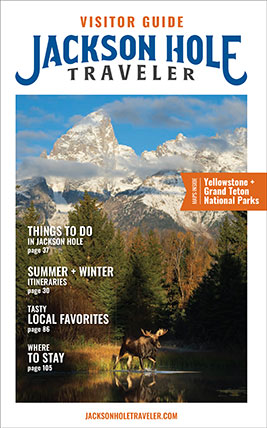Tom Mangelsen’s photographs of the Jackson Hole area and its wildlife are as legion as they are legendary. Perhaps you’ve seen them without realizing who the man was behind the lens: a grizzly at dawn, lumbering its way through the shallows of the Snake River in Grand Teton National Park with the majestic Mount Moran in the background; three great horned owls sitting comfy in a nest created by a heart-shaped hollow of a cottonwood tree; or a landscape portrait featuring the brilliant oranges and yellows of aspen trees swaying beneath the Teton Range in autumn.
“Having a passion and interest in a particular subject is what makes a difference for a photographer,” Mangelsen says.
Internationally Acclaimed Wildlife Photographer
Living on the edge of Grand Teton National Park, Tom has been photographing both winged and footed wildlife here for more than 40 years. His father, who was an avid sportsman when Tom was growing up in Nebraska, heavily influenced the then-would-be photographer’s love of nature and the outdoors. While accompanying his dad on duck hunts, he gleaned from these adventures important lessons for photographing in the field — most notably patience and understanding animal behavior.
“I spend a tremendous amount of time observing animals’ behavior.”
One of the most prolific nature photographers of our time, Tom Mangelsen's photographs have been exhibited internationally and his limited edition photos are coveted by collectors. In May 2024, Tom was featured in NATURE, an award-winning signature PBS documentary series focusing on natural history and wildlife. One episode, titled Grizzly 399: Queen of the Tetons, features Tom in a starring role, giving voice to the story behind the most famous grizzly bear* in the world, her twists and turns, and the hope and heartbreak behind every bear jam.
But Tom is as much a conservationist as he is an artist. In 2011 he was named Conservation Photographer of the Year by Nature's Best Photography, placing his work in the permanent collection at the Smithsonian's National Museum of Natural History in Washington, D.C. Mangelsen is the co-founder of the Cougar Fund, a founding Fellow of The International League of Conservation Photographers, on the international advisory council for the Jane Goodall Institute and a board ambassador for the Jackson Hole Conservation Alliance. He has also been named one of the "40 Most Influential Nature Photographers" by Outdoor Photography.
* The world-famous beloved bruin was tragically and accidentally killed by a driver in the Snake River Canyon in October 2024. Mengelsen took beyond numerous photos of 399 over a several-year period. Visit Mangelsen—Images of Nature Gallery to experience the wonder of nature through his lens. The gallery features 200-plus fine art photographs from all seven continents.
Quick Facts
Photo equipment needed:
“One has to have a good kit and a variety of lenses,” says Mangelsen
His lens suggestions?
- Wide-angle lens 24-120mm,
- 70mm-200mm
- 28mm to 300mm
Have Passion, Knowledge of Your Subject
“Having a passion and interest in a particular subject is what makes a difference for a photographer,” Mangelsen says. “The more a person learns about a subject [animal, bird] the better off they will be.”
Animals and their behavior are “pretty much consistent,” he says, so you have to learn to anticipate their movement before setting up and taking the shot.
That anticipation is what Mangelsen calls “pre-visualization.”
“Pre-visualize and think about the possibilities,” he says. “Composition is critical, as is light.”
In addition to composition and light, subject, texture and form are also key elements for a good image.
The best times for photography are during the “magic hour”— sunrise and sunset. Not only is wildlife more plentiful than during midday hours, but the light is both dramatic and ideal.
“With the new digital equipment you can almost shoot in the dark, so it’s given us all the opportunity to shoot pictures we weren’t able to 5 or 10 years ago,” says Mangelsen.
One thing that’s really important for a nature and wildlife photographer is to respect your subject and give them enough space — 25 yards or more for big animals.
Visit His Gallery For Inspiration
To really get your creative juices going and gain inspiration for your own foray into Grand Teton National Park with your camera, visit Mangelsen’s gallery — Mangelsen: Images of Nature Gallery — in downtown Jackson at 170 N. Cache. Mangelsen has also published several books, including "Grizzly 399: The World's Most Famous Mother Bear," “Images of Nature: The Photographs of Thomas Mangelsen,” “Polar Bear: Born of the North Wind,” "Grizzlies of Pilgrim Creek: An Intimate Portrait of 399,” “The Last Great Wild Places: Forty Years of Wildlife Photography by Thomas D. Mangelsen” and “Spirit of the Rockies: The Mountain Lions of Jackson Hole.” Head over to his website, too: mangelsen.com.


